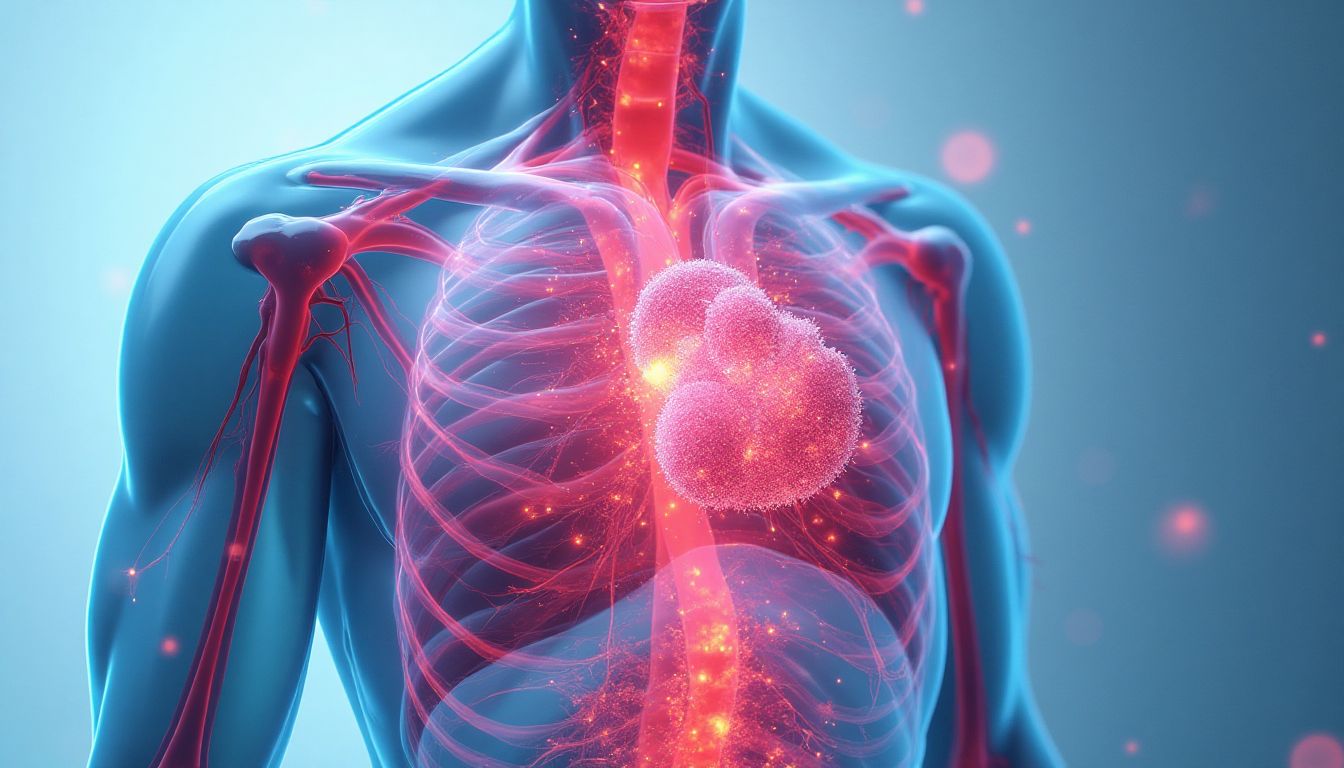Introduction: The New Frontier of Immortality
To live is the rarest thing in the world. Most people exist, that is all. - Oscar Wilde. Wilde’s words resonate deeply when we think about the quest for enhancing life, not merely existing but achieving extraordinary longevity and vitality. As we traverse the boundaries of what is possible, what if our lifelines could be boundlessly extended by the marvels of nanotechnology within our very bloodstream?
Picture this: a microscopic army of nanobots maintaining perfect equilibrium in our bodies, making diseases a distant memory. Are we on the brink of eternal life, not through traditional medicine but by harnessing the microscopic might of technology? Authors like Ray Kurzweil and Joydeep Sen Sarma have passionately discussed the merging of biology and machinery, and the intriguing idea proposed by Aubrey de Grey about defeating aging. How close are we to this vision?
The Science Behind Nanotech-Enhanced Circulatory Systems
The world of nanotechnology is akin to diving into the ocean with a microscope, witnessing wonders beyond the scope of ordinary eyes. With nanotechnology, the medical field has discovered doors leading to incredibly advanced solutions. Imagine these nanobots like tiny underwater experts navigating the rivers of your body, fixing leaks and flushing out the bad stuff.
Nanoscale technology functions at the atomic and molecular level. It's like playing with Lego bricks the size of atoms. This precision is the secret sauce that allows interactions with biological systems. Picture your bloodstream like a bustling freeway, and nanobots are the finely tuned vehicles expertly weaving in and out to keep everything flowing smoothly.
How do these tiny helpers tweak our blood? It's kind of like adjusting the knobs on a high-tech music mixer, optimizing for the best sound. Through ingenious mechanisms, nanobots could adjust oxygen levels, manage glucose concentrations, and even take out the toxic trash swiftly and accurately. They act like highly attentive physicians on the frontline, ensuring every beat of your heart propels your health upwards.
Curious yet? Nanotechnology promises a radical evolution in health management. But remember, even spaceships faced trials before touchdown. In our quest to eternalize blood, challenges abound, but the promise is worth every heartbeat.
Health Benefits of Nanotech-Enhanced Blood Systems
Nanotechnology in the realm of health isn’t just pie in the sky; it's like having real superheroes (albeit very tiny) guarding your body 24/7. Imagine these little warriors running patrol in your veins, ready to stave off illness at the drop of a hat. The health benefits of such futuristic technology promise to reshape the landscape of medicine as we know it.
Disease Prevention and Management
Imagine a world where doctors become less like crisis responders and more like wellness coaches. With nanobots diligently monitoring blood chemistry and zapping anomalies as they arise, life-threatening diseases like diabetes could become as manageable as a bad hair day. The key is their ability to respond instantly to any internal alerts like a vigilant mom waking up to a baby’s sniffle.
Enhanced Healing and Recovery Times
Get injured? Let the nanobots take over and heal in record time! Forget those days of languishing in bed, streaming everything on Netflix while nursing a sprained ankle. Thanks to precise delivery of medicines directly to wounded tissues, post-surgery recoveries and injuries might become mere blips on the radar. Imagine healing as quickly as superheroes do in movies—minus the CGI.
Ethical Considerations and Societal Implications
As we step closer to what almost sounds like everlasting life, we're also stepping into a minefield of ethical quandaries. The societal implications of having the keys to biological immortality go beyond mere scientific curiosity, touching upon deep philosophical waters.
Accessibility and Inequality
Sure, living forever sounds great, but who gets to benefit? If these bleeding-edge technologies become exclusive to the elite, we might just end up widening the gap between the haves and have-nots. Think of it as giving everyone wings, but only a few get the user manual (courtesy of some socio-politically charged Orwellian nightmare). Tackling these disparities would require more than just a technological breakthrough but a societal tipping point.
The Question of What It Means to be Human
If we conquered death, would we lose the essence of life? As immortality becomes feasible, we are forced to ponder tough questions: would our sense of identity and legacy, our reason for rushing to achieve and make memories, lose its charm? Philosophers, sociologists, and ethicists need to join this conversation to preserve the very meaning of being human in the face of such revolutionary change.
Current Advancements in Nanotechnology and Beyond
Our quest to cheat death isn't as far-fetched as it once seemed. In labs around the globe, scientific pioneers push the boundaries of what's possible, crafting a future where nanotechnology could redefine healthcare. Imagine a world where a mere pinprick unleashes a horde of Arthur C. Clarke's magic nanobots within you, monitoring, diagnosing, and curing at the source.
Breakthrough Research Projects
The vanguard of this movement is marked by groundbreaking research that teeters at the edge of known science. Around the world, universities and private firms are forming alliances, creating hives of innovation. At the Massachusetts Institute of Technology (MIT), researchers collaborate with Harvard Medical School, leading futuristic projects like introducing nanoparticles that attack tumors from within, minimizing collateral damage to healthy cells.
Meanwhile, in the research centers at Stanford University, nano-surveillance systems that mimic the human immune response stand on the precipice of clinical deployment. These collaborations not only expand our understanding but also delineate a roadmap for what lies ahead in nanomedicine.
Real-world Applications and Trials
Translating theory into practice has seen its fair share of successes. The application of nanosensors in glucose monitoring for diabetic patients already paints a hopeful picture. Products designed by companies like Medtronic have improved the quality of life for thousands, offering real-time data collection and unprecedented control over health outcomes.
Furthermore, early-phase clinical trials of nanobots targeting cardiovascular ailments have shown encouraging signs of reducing plaque build-up with minimal invasiveness. The development of Boehringer Ingelheim's intelligent nanocapsules heralds a future where personalized ammunition against chronic diseases is conceivable, highlighting both the promise and complexity of the road ahead.
Challenges in Developing and Implementing Nanotech Solutions
Yet, as with any innovation, the path is fraught with obstacles, quirks in design and deployment that require overcoming. With each breakthrough, new challenges emerge to test our ingenuity and persistence. While the dream of eternal life dances before us, the hurdles present cautionary tales of ambition unchecked by reality.
Technical Obstacles
The nanoscale world, though abundant in possibilities, is no less volatile. Ensuring that nanobots retain their structural integrity and intended function in the myriad environments within the human body is a monumental task. Factors such as the potential bioaccumulation of materials and mitigating unintended molecular interactions demand rigorous scrutiny.
Moreover, the intricacy of molecular communication poses a labyrinthine challenge. Crafting a language —protocols and interfaces that nanobots use to relay and receive information in a constantly shifting biological landscape— is a multi-faceted problem requiring precision akin to stitching threads of a cosmic tapestry.
Regulatory and Safety Concerns
Amongst the bevy of risks lie those linked to navigating the maize of regulatory approvals, ensuring public welfare while encouraging innovation. The vast unknowns of nanobot-human biology interactions necessitate the development of focused, coherent policy frameworks.
The landscape is dotted with organizations such as the U.S. Food and Drug Administration (FDA) and the World Health Organization (WHO). They're grappling to adapt regulatory precepts to account for the exigencies of these advanced technologies, aspiring to safeguard while not hindering progress.
At the heart of public acceptance lies the assurance of safety verified by data-driven evidence, akin to a bulwark defending against skepticism and fear. As researchers and policymakers join forces, the goal remains abundantly clear: to unravel the enigma of intelligent medicine without sacrificing the sanctity of human health.
AI Solutions: How Would AI Tackle This Issue?
Artificial Intelligence (AI) is set to play a pivotal role in overcoming the challenges faced in developing nanotech-enhanced circulatory systems. Imagine a world where intelligent algorithms constantly analyze our health and optimize medical treatments in real-time. By harnessing AI, researchers can innovate at a pace previously thought impossible.
AI's ability to sift through enormous datasets enables it to predict complications in blood chemistry and optimize the design of nanobots. Using IBM Watson or similar platforms, scientists can simulate how nanobots would function within biological systems, allowing them to forecast potential reactions and outcomes, which enhances the efficacy of these tiny machines.
First, AI-powered models will analyze biological behavior to create predictive algorithms. This means each person could have a customized health model based on their specific genetics, lifestyle, and existing conditions. Such individualized care represents a profound shift in healthcare, moving from a one-size-fits-all approach to precision medicine.
Moreover, collaboration between AI engineers and biologists is essential, as these fields reveal the intricacies of human biology and technology. By working hand-in-hand, they can create adaptive systems that respond dynamically to individual health needs. Sounds ambitious, right? Yet, the reality is that the keys to this revolution are already in our hands.
AI can also assist in the regulatory approval process. As algorithms learn from pilot studies and real-world applications, they can generate reports that showcase the safety and reliability of nanobots in healthcare settings. This will not only expedite the time required for product approval but also enhance public trust in nanotechnology applications.
Actions Schedule/Roadmap
The journey from concept to implementation is always a marathon, not a sprint. Here's a blueprint modeled after progressive project management timelines for the successful integration of nanotech-enhanced systems into healthcare:
Day 1: Assemble Core Team
Put together a dynamic team comprising nanotech experts, AI engineers, biotechnologists, ethicists, and healthcare professionals from institutions like MIT, Stanford University, and Harvard University. Diversity in expertise is vital for this revolutionary endeavor.
Day 2: Survey Current Technologies
Compile an extensive report on existing advancements in nanotechnology and AI within the healthcare landscape. Include foundries like The New York Times and scientific publications that can provide context and validation.
Day 3: Conduct Initial Brainstorming Sessions
Host workshops to generate innovative ideas for nanobot functionalities. Utilize methods like Design Thinking approaches to encourage out-of-the-box thinking.
Week 1: Literature Reviews
Engage in a thorough review of relevant research papers regarding nanotechnology in blood chemistry management. Leverage databases like PubMed for comprehensive insights.
Week 2: Partner with Universities
Establish collaborations with top institutions like Caltech for access to state-of-the-art facilities and ongoing nanotechnology projects.
Week 3: Prototype Designs
Initiate design processes utilizing simulation software such as MATLAB for creating early-stage prototypes based on the brainstormed concepts.
Month 1: Ethical Compliance Checks
Review ethical guidelines by collaborating with organizations like the National Bioethics Advisory Commission. Ensuring ethical practices from the start is paramount.
Month 2: Begin Testing Phase
Start small-scale tests with biological samples to evaluate the efficacy of nanobot designs. Employ AI models for predictive analysis as testing progresses.
Month 3: Expand Testing Protocols
Refine prototypes and conduct further testing, incorporating feedback and results from initial tests to optimize designs before moving on to larger studies.
Year 1: Clinical Trials Phase 1
Prepare applications for clinical trial approvals with agencies like the FDA. This includes detailed reports on anticipated efficacy based on data extracted from the testing phases.
Year 1.5: Data Collection and Analysis
Implement rigorous data collection strategies during the clinical trials to build a robust dataset that informs future iterations of the nanotech solutions.
Year 2: Full-scale Clinical Trials
Begin comprehensive trials with a broader participant demographic, assessing the long-term effects of the nanobots on health, while ensuring consistency in data reporting and evaluation protocols.
Conclusion: Embracing the Future of Healthcare
As human beings, we yearn for longevity, better health, and perhaps, immortality. The dream of nanotech-enhanced circulatory systems is not merely a concept rooted in science fiction—it's a tantalizing prospect on the horizon of modern medicine. With the relentless march of technology, particularly the integration of AI into healthcare, we now have unprecedented opportunities to redefine life itself.
This symbiosis between medicine and technology poses a dual-edged sword. As we uncover the potential to live longer and healthier lives, we must also navigate the murky waters of ethics and accessibility. Questions arise about who will benefit from these advancements and whether we can ensure fairness in distribution.
In this era of transformational changes, the responsibility lies with us to embrace not merely the scientific promise but also the ethical implications that come with it. If we care for the broader societal implications, we may be on the cusp of a remarkable evolution in human health and wellness.
Imagine a world where diseases are minimized, where recovery is swift, and age becomes merely a number instead of a limiting factor. We are entering an unprecedented chapter in human history—one where our blood flows with a renewed vigor, infused by nanotechnology and guided by the intelligence of AI. Together, let’s turn these visionary dreams into reality!
FAQ: Understanding Nanotech-Enhanced Circulatory Systems
What are nanobots, and how do they work?
Nanobots are minuscule machines, usually much smaller than a single cell, built at a molecular scale. They can travel through our bloodstream to do important tasks. For example, they might deliver medicine directly to where it’s needed, monitor our health, or help break down harmful substances. Imagine them as tiny superheroes that work tirelessly to keep our body safe and healthy!
Are there any risks associated with nanotechnology in medicine?
Yes, like any new technology, nanotechnology has risks. Some risks include:
- Unknown effects on the body: We don’t fully understand how nanobots might react with our biological systems.
- Regulatory challenges: We need strict guidelines to ensure they are safe for everyone before they hit the market.
- Potential side effects: Just like with any medicine, nanobots could cause unwanted side effects.
Researchers at places like MIT and Harvard University are working hard to study these risks to find safe ways to use nanotechnology.
How does AI contribute to the development of nanotech solutions?
AI, or artificial intelligence, plays a big role in developing nanotechnology. Here’s how:
- Data Analysis: AI can look at large sets of health data to spot patterns and predict issues in blood chemistry.
- Simulations: It helps create computer simulations to see how nanobots will behave inside our bodies, which allows researchers to make better designs.
- Learning: AI continually learns from new data gathered, improving its predictions and the overall effectiveness of treatments.
Institutions like Stanford University are leading the way in integrating AI with nanotechnology to enhance healthcare outcomes.
What is the timeframe for realizing nanotech-enhanced blood systems?
The timeline for making these nanotech enhancements a reality can vary. It might take several years or even a couple of decades. Here’s a rough idea of what influences the timeline:
- Research progress: How quickly scientists can develop and test new technologies.
- Clinical trials: Successful trials are needed to show these systems are safe and effective for people.
- Regulatory approval: Governments must approve these solutions before they can be used widely.
Will nanotech-enhanced circulatory systems be accessible to everyone?
Accessibility is a big concern. It will depend on several factors:
- Cost: As with most new technologies, it may be expensive at first.
- Healthcare system: How well will healthcare systems integrate and distribute these new treatments?
- Policy: Government policies may play a role in making sure everyone has access.
Getting input from communities and advocates can help ensure that these life-changing technologies are available to all, regardless of income or location.
Wait! There's more...check out our gripping short story that continues the journey: The Canvas of Forever
Disclaimer: This article may contain affiliate links. If you click on these links and make a purchase, we may receive a commission at no additional cost to you. Our recommendations and reviews are always independent and objective, aiming to provide you with the best information and resources.
Get Exclusive Stories, Photos, Art & Offers - Subscribe Today!





























Post Comment
You must be logged in to post a comment.